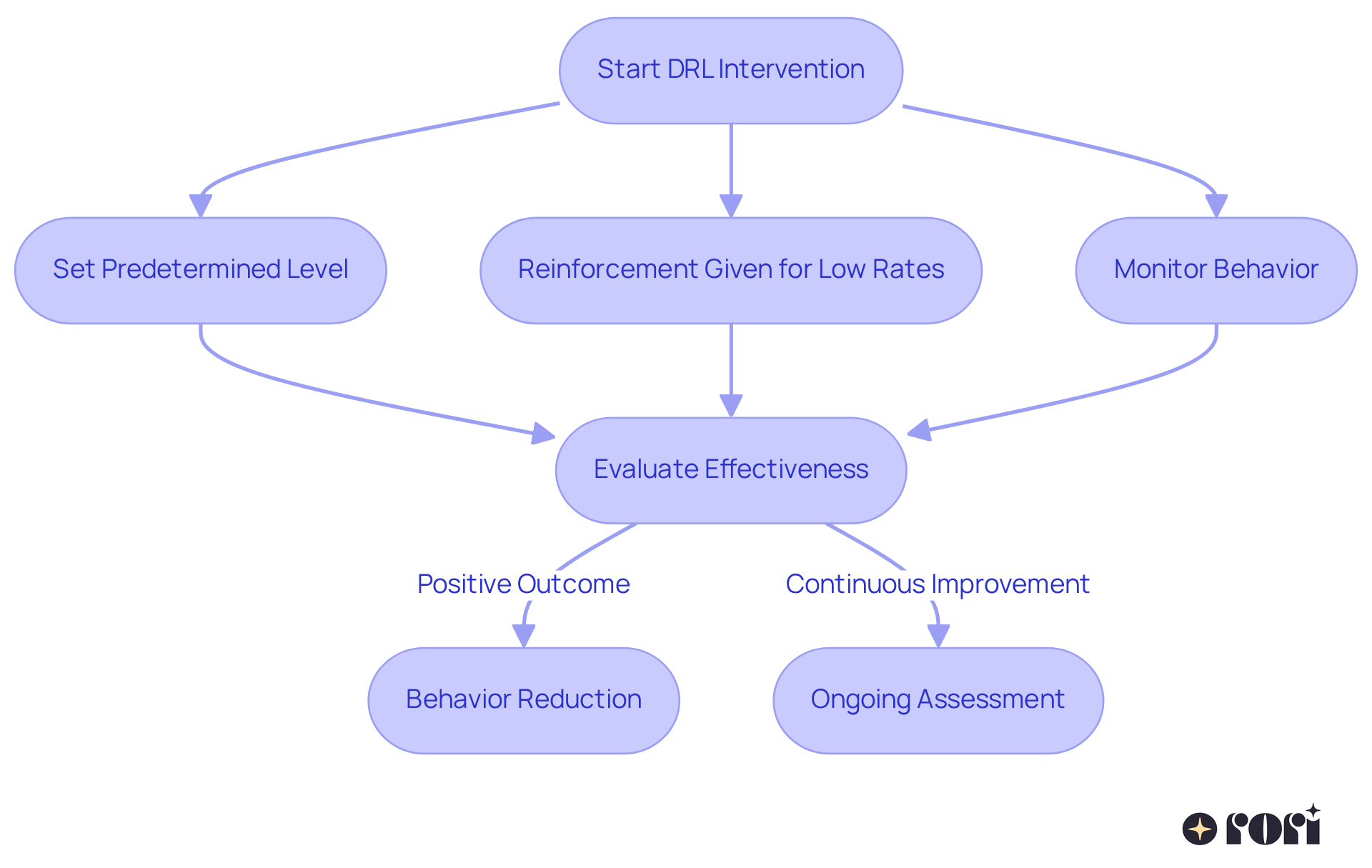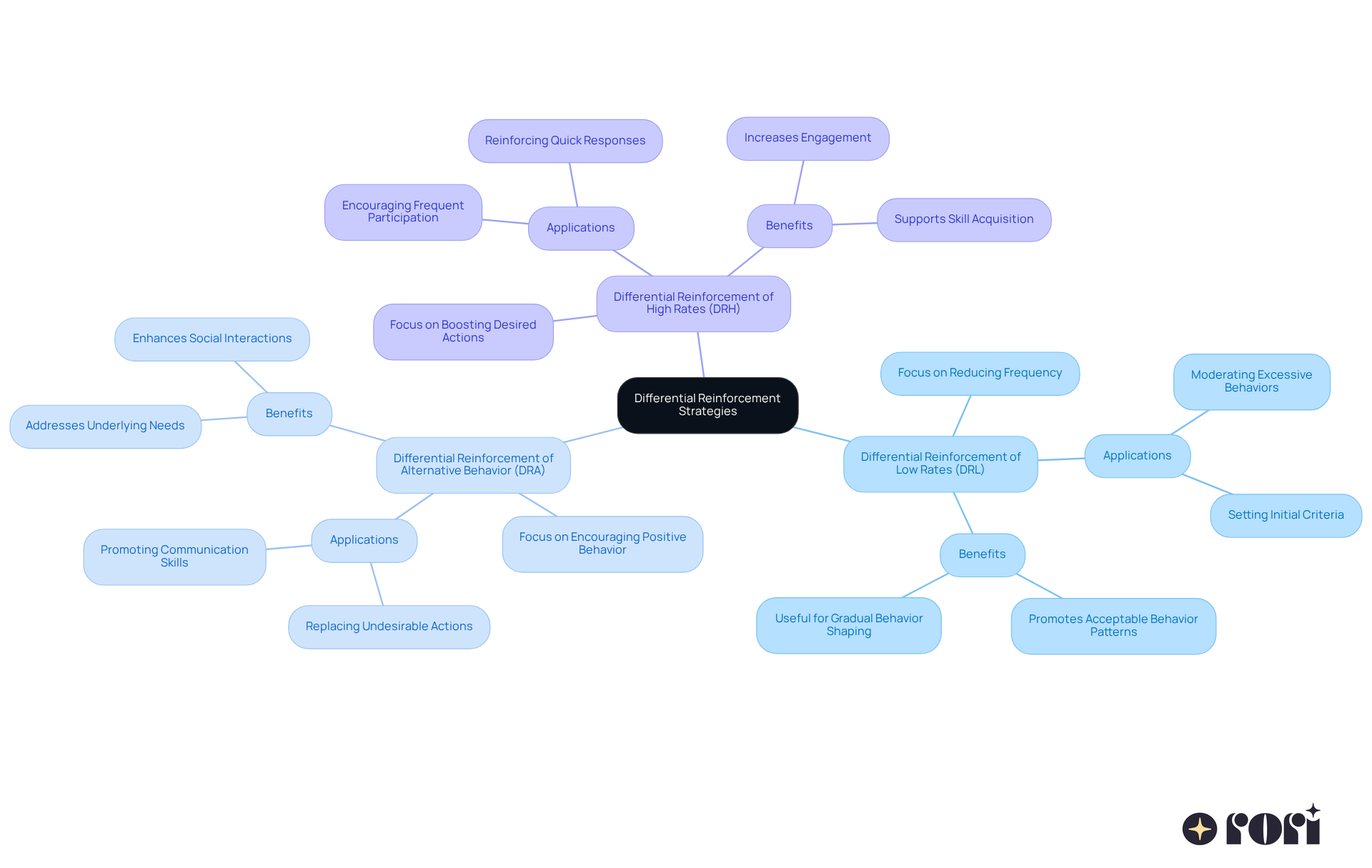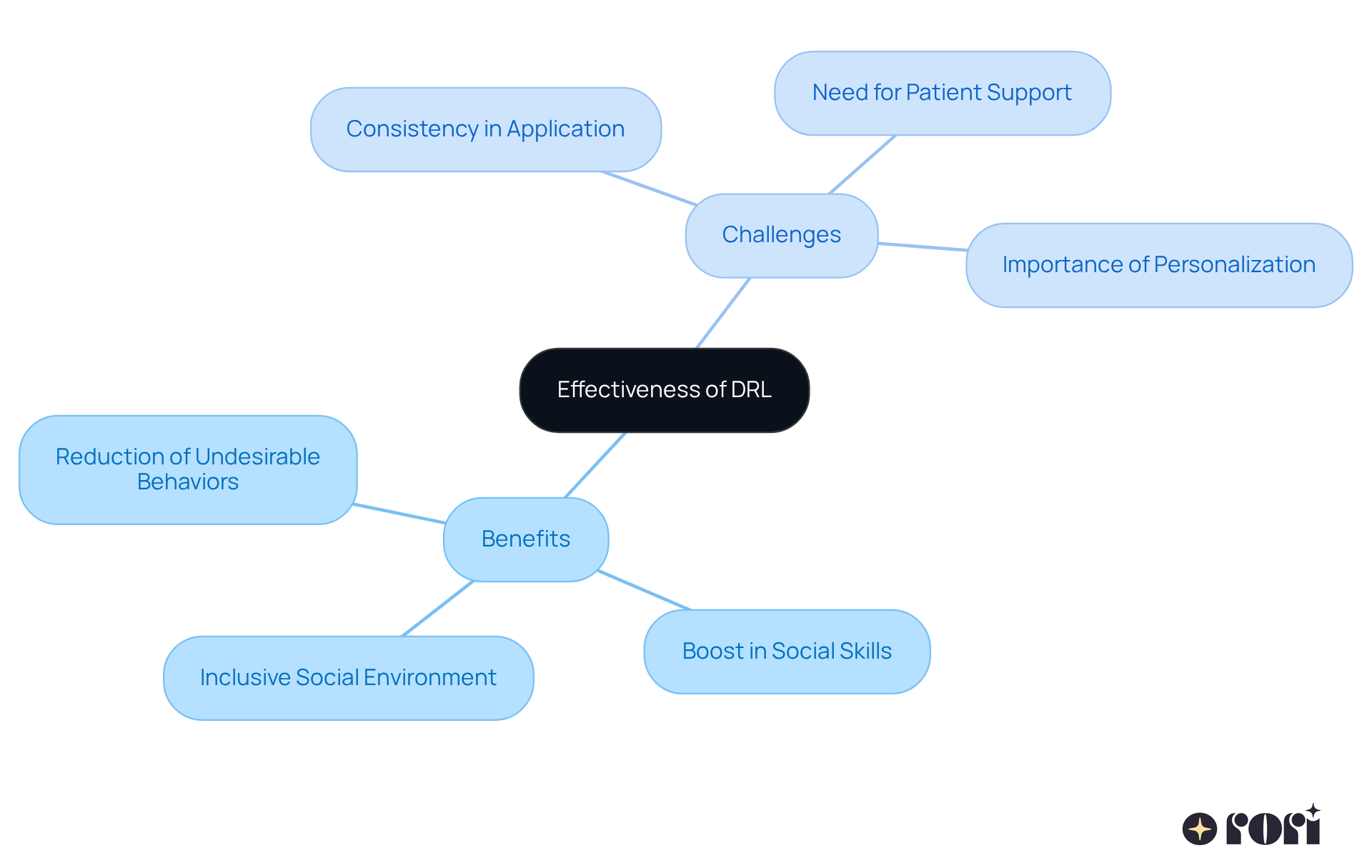This article dives into Differential Reinforcement of Low Rates (DRL) in Applied Behavior Analysis (ABA), highlighting how it can be a game-changer for parents looking to manage and reduce certain behaviors in their children—without having to eliminate them completely. 🌟
You might find it interesting that DRL is quite effective in decreasing those pesky behaviors, like excessive interruptions, while also nurturing the development of social skills. Research backs this up, showing significant reductions in challenging behaviors among individuals facing behavioral hurdles. So, let’s explore this together and see how DRL can make a positive impact in your parenting journey!
Understanding the nuances of behavior modification can feel overwhelming for many parents. Navigating the complexities of Applied Behavior Analysis (ABA) doesn’t have to be a solo journey! One strategy that shines in this realm is Differential Reinforcement of Low Rates (DRL). It’s a powerful tool that helps reduce the frequency of certain behaviors while still allowing them to happen at acceptable levels. This approach fosters a more socially acceptable frequency of actions and supports the development of essential skills in children facing behavioral challenges.
But how can parents effectively weave DRL into their daily routines? It’s all about ensuring meaningful progress while respecting your child’s unique expression. Let’s explore this together! 🌟
The drl aba meaning refers to Differential Reinforcement of Low Rates (DRL), which is a strategic intervention in Applied Behavior Analysis (ABA) designed to help reduce the frequency of certain actions while still allowing them to happen at a lower rate. In this method, reinforcement is given only when the action occurs at or below a predetermined level within a specific timeframe. This approach works wonders for actions that are socially acceptable but may occur too frequently, like talking out of turn or excessive hand-flapping. By reinforcing these lower rates, the drl aba meaning encourages individuals to engage in these behaviors less often, fostering a more socially acceptable frequency without completely eliminating the action.
The benefits of using DRL, which aligns with drl aba meaning, to modify behavior are significant, especially for individuals with Autism Spectrum Disorders, ADHD, and other behavioral challenges. Research shows that interventions using DRL can lead to a decrease in problematic actions by an impressive average of 85% when the alternative action effectively serves the same purpose. Plus, studies indicate that different reward strategies can have success rates between 70% and 90% when implemented correctly. For instance, Benjamin L. Handen found that a DRL schedule was effective in reducing repetitive speech in an autistic teenager, which underscores the drl aba meaning and the effectiveness of this method.
There have been successful implementations of DRL aba meaning in autism therapy, demonstrating its effectiveness in reducing specific actions. One study involving an autistic adolescent showed that a DRL schedule effectively decreased the rate of repetitive speech from a mean of 4.7 to less than 0.3 repetitions per minute over 18 months. This intervention not only maintained those low levels but also showed lasting effectiveness at follow-ups six and fourteen months later. Handen noted that when the contingencies were reintroduced, the low levels of responding returned, demonstrating the method's reliability.
Recent studies emphasize the need for careful assessment and systematic implementation to maximize DRL's effectiveness. As our understanding of behavior and neuroscience deepens, the use of technology for real-time observation and reinforcement is expected to enhance DRL interventions. This aligns with emerging trends in the field, where technology is increasingly used to support behavior modification strategies, making them more effective in fostering positive behavioral changes in youth with autism. Additionally, Rori Care’s commitment to automatic data collection ensures that clinical sessions are recorded securely, allowing for ongoing evaluation and personalized planning tailored to each child's unique needs. Let’s explore this together!

The term drl aba meaning refers to Differential Reinforcement of Low Rates (DRL), which is one of several strategies used in Applied Behavior Analysis (ABA), alongside:
While DRA focuses on encouraging a positive behavior to replace an undesired one, DRH aims to boost the frequency of a desired action. DRL, on the other hand, is all about reducing the frequency of a behavior without eliminating it entirely. This can be especially helpful for behaviors that aren’t problematic on their own but can become disruptive if they happen too often.
Understanding the drl aba meaning is crucial for parents and practitioners when selecting the right intervention for a young person’s unique behavioral challenges. By engaging in caregiver education, parents can deepen their understanding of these strategies. This knowledge not only supports effective implementation of the DRL ABA meaning but also fosters improved behavioral outcomes and enhances overall family dynamics. Let’s explore this together! By making informed decisions, you can positively impact your child’s progress and create a supportive environment for everyone.

Implementing Differential Reinforcement of Low Rates (DRL), which aligns with drl aba meaning, can be a game-changer for parents and caregivers looking to reduce unwanted behaviors. First things first, it's important to identify the specific behavior that needs some attention. For instance, if your little one tends to interrupt during conversations, you might set a goal of allowing just two interruptions per hour. This way, you have a clear reinforcement criterion to work with!
When your child meets this goal, don’t forget to celebrate their success! A simple verbal praise or a small reward can go a long way. Setting measurable goals is key, as it gives you a clear benchmark to track progress and see improvements over time.
Now, consistency is crucial! Make sure to stick to the DRL schedule and keep an eye on your child’s progress. Our conduct care engine is designed to refresh intervention strategies based on what’s working, which is essential for adapting your approach as your child grows. Did you know that research shows about 40-50% of kids improve their social skills through intensive ABA therapy? This highlights just how effective structured interventions like the drl aba meaning can be.
As your child learns to manage their actions better, consider gradually adjusting the reward criteria to encourage even more growth. Experts suggest that continuously assessing and tweaking your reinforcement strategy can really boost the effectiveness of the DRL aba meaning, making it a flexible tool for managing behavior in children with autism. Plus, understanding DRL alongside other strategies, like Differential Reinforcement of Alternative Actions (DRA) or Differential Reinforcement of Incompatible Actions (DRI), can provide a more comprehensive approach to behavior management.
By equipping yourself with ABA principles and strategies, you can truly support your child's behavioral development. Let’s explore this together! We’re here to help you every step of the way!

The effectiveness of Differential Reinforcement of Low Rates (DRL) can be evaluated through various metrics, like how often target actions occur and how they affect a young person's social interactions. One of the main benefits of DRL is its ability to reduce undesirable behaviors without completely eliminating them. This balance is crucial for helping young individuals maintain their autonomy and self-expression.
Research shows that DRL can significantly boost social skills development. For instance, studies have found that young people involved in DRL interventions often enjoy better interactions with peers, creating a more inclusive social environment. Isn’t that wonderful?
However, implementing DRL does come with its challenges. Consistent application is key; fluctuations in support can lead to frustration if a young person struggles to meet the set standards. Parents and caregivers need to be patient and adaptable, adjusting the support schedule as necessary to ensure steady progress. A study even highlighted that kids who received tailored reinforcement schedules showed increased engagement and fewer troublesome behaviors, emphasizing the importance of personalized strategies in behavioral interventions.
Overall, when done thoughtfully, the meaning of DRL ABA serves as a powerful tool in the behavioral intervention toolkit. It encourages positive behavior change and enhances social skills in individuals with autism. By understanding both the benefits and challenges of DRL, parents can better support their child's development and navigate the complexities of behavioral therapy. Let’s explore this together!

Understanding Differential Reinforcement of Low Rates (DRL) offers parents and caregivers a powerful tool to manage and modify behaviors in children, especially those facing challenges like autism or ADHD. By focusing on reducing the frequency of certain behaviors while still allowing them to occur at lower rates, DRL promotes a balanced approach to behavior modification that supports social acceptance and personal expression.
Throughout this article, we’ve explored key insights into the implementation and effectiveness of DRL. From defining DRL and its role within broader differential reinforcement strategies to practical applications and the importance of consistent reinforcement, we’ve emphasized how this method can foster positive behavioral changes. Success stories and research findings illustrate how DRL can significantly enhance social skills and interactions, making it a valuable strategy for parents navigating the complexities of behavior management.
In conclusion, embracing DRL not only empowers parents to address specific behavioral challenges but also enriches the overall developmental journey of their children. By understanding and applying these techniques, caregivers can create supportive environments that encourage growth and learning. As the field of Applied Behavior Analysis continues to evolve, staying informed and adaptable will be crucial in maximizing the benefits of DRL. Let’s explore this together, leading to improved outcomes for children and families alike!
What is Differential Reinforcement of Low Rates (DRL)?
Differential Reinforcement of Low Rates (DRL) is a strategic intervention in Applied Behavior Analysis (ABA) aimed at reducing the frequency of certain behaviors while still allowing them to occur at a lower rate. Reinforcement is provided only when the behavior happens at or below a predetermined level within a specific timeframe.
What types of behaviors can DRL help modify?
DRL can help modify behaviors that are socially acceptable but occur too frequently, such as talking out of turn or excessive hand-flapping.
What are the benefits of using DRL in behavior modification?
The benefits of using DRL include significant reductions in problematic behaviors, with an average decrease of 85% when an alternative action effectively serves the same purpose. Success rates for different reward strategies can range from 70% to 90% when implemented correctly.
Can you provide an example of DRL's effectiveness?
Yes, a study by Benjamin L. Handen demonstrated that a DRL schedule effectively reduced repetitive speech in an autistic teenager, showcasing the effectiveness of this method.
How effective is DRL in autism therapy?
A study involving an autistic adolescent showed that DRL effectively decreased the rate of repetitive speech from an average of 4.7 to less than 0.3 repetitions per minute over 18 months, with lasting effectiveness observed at follow-up assessments.
What factors are important for maximizing the effectiveness of DRL?
Careful assessment and systematic implementation are essential for maximizing DRL's effectiveness. Additionally, the use of technology for real-time observation and reinforcement is expected to enhance DRL interventions.
How is technology being utilized in DRL interventions?
Technology is increasingly being used to support behavior modification strategies, allowing for real-time observation and reinforcement, which can foster positive behavioral changes in youth with autism.
What is Rori Care's approach to data collection in DRL interventions?
Rori Care emphasizes automatic data collection to securely record clinical sessions, enabling ongoing evaluation and personalized planning tailored to each child's unique needs.